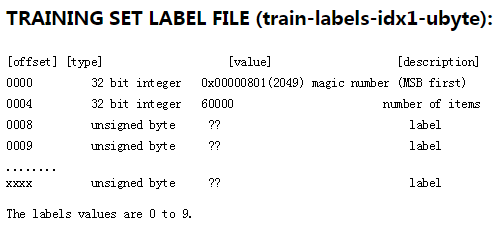一:MNIST数据集
MNIST是一个包含很多手写数字图片的数据集,一共4个二进制压缩文件

分别是test set images,test set labels,training set images,training set labels
training set包括60000个样本,test set包括10000个样本。
test set中前5000个样本来自原始的NISTtraining set,后5000个样本来自原始的NIST test set,因此,前5000个样本比后5000个样本更简单和干净。
每个样本是28*28像素的图片




二:tensorflow构建模型识别MNIST
导入数据:
from tensorflow.examples.tutorials.mnist import input_data mnist = input_data.read_data_sets('MNIST_data', one_hot=True)
import tensorflow as tf
x = tf.placeholder(tf.float32, shape=[None, 784]) y_ = tf.placeholder(tf.float32, shape=[None, 10]) #真实值 W = tf.Variable(tf.zeros([784, 10])) b = tf.Variable(tf.zeros([10]))
y = tf.nn.softmax(tf.matmul(x, w) + b) #预测值
softmax的目的:将输出转化为是每个数字的概率
#计算交叉熵 cross_entropy = tf.reduce_mean(-tf.reduce_sum(y_label *tf.log(y), reduction_indices=[1])) train = tf.train.GradientDescentOptimizer(0.5).minimize(cross_entropy)
交叉熵:衡量预测值与真实值之间的差别,当然是越小越好
公式为:

其中y'是真实值,y为预测值
最后用梯度下降法优化参数即可
在Session中运行graph:
total_steps = 5000 batch_size = 100 with tf.Session() as sess: sess.run(tf.global_variables_initializer()) for step in range(total_steps+1): batch_x, batch_y = mnist.train.next_batch(batch_size) sess.run(train,feed_dict={x: batch_x, y_label: batch_y})
预测正确率:
correct_prediction = tf.equal(tf.argmax(y, axis=1), tf.argmax(y_label, axis=1))
accuracy = tf.reduce_mean(tf.cast(correct_prediction, tf.float32))
tf.argmax()函数返回axis轴上最大值的index
tf.equal()函数返回的是布尔值,需要用tf.cast()方法转为tf.float32类型
最后在test set上进行预测:
step_per_test = 100
if step % step_per_test == 0:
print(step, sess.run(accuracy, feed_dict={x: mnist.test.images, y_label: mnist.test.labels}))
完整代码如下:

from tensorflow.examples.tutorials.mnist import input_data import tensorflow as tf mnist = input_data.read_data_sets('MNIST_data/', one_hot=True) x = tf.placeholder(tf.float32, [None, 784]) y_label = tf.placeholder(tf.float32, [None, 10]) w = tf.Variable(tf.zeros([784, 10])) b = tf.Variable(tf.zeros([10])) y = tf.nn.softmax(tf.matmul(x, w) + b) #计算交叉熵 cross_entropy = tf.reduce_mean(-tf.reduce_sum(y_label *tf.log(y), reduction_indices=[1])) train = tf.train.GradientDescentOptimizer(0.5).minimize(cross_entropy) #eval correct_prediction = tf.equal(tf.argmax(y, axis=1), tf.argmax(y_label, axis=1)) accuracy = tf.reduce_mean(tf.cast(correct_prediction, tf.float32)) total_steps = 5000 batch_size = 100 with tf.Session() as sess: sess.run(tf.global_variables_initializer()) for step in range(total_steps+1): batch_x, batch_y = mnist.train.next_batch(batch_size) sess.run(train,feed_dict={x: batch_x, y_label: batch_y}) step_per_test = 100 if step % step_per_test == 0: print(step, sess.run(accuracy, feed_dict={x: mnist.test.images, y_label: mnist.test.labels}))
运行结果:

准确率为0.92左右
后面我们会构建更好的模型达到更高的正确率。
相关链接:
基于tensorflow的MNIST手写字识别(一)--白话卷积神经网络模型
